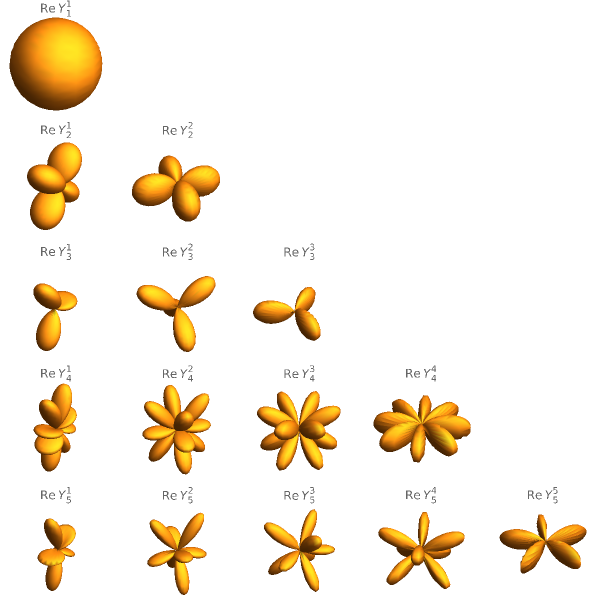Spherical Harmonics
Spherical Harmonics
Spherical Harmonics are special functions that appear ubiquitously in physical systems that admit spherical symmetry.
Definition
Definition
Spherical harmonics are defined as the solution of the following Eigenvalue problem
1
Sinϑ
∂
∂ϑ
∂
∂ϑ
1
2
Sin
2
∂
∂
2
φ
m
Y
l
Every solution to of this equation, denoted by , is labeled by the integers l and m. The integer m is restricted to take values from -l to l and counts the degeneracy g(l) = l(l+1). The harmonics and are not really independent but are related by a complex conjugation. They satisfy the relation
m
Y
l
m
Y
l
-m
Y
l
*
m
Y
l
m
(-1)
-m
Y
l
In Wolfram Language spherical harmonics are implemented by the function .
◼
Explicit expression for the first few spherical harmonics.
In[3]:=
TableForm@Table[SphericalHarmonicY[l,m,θ,ϕ],{l,0,4},{m,0,l}]//TraditionalForm
m
Y
l
Out[3]//TraditionalForm=
0 Y 0 1 2 π | ||||
0 Y 1 1 2 3 π | 1 Y 1 1 2 3 2π ϕ | |||
0 Y 2 1 4 5 π 2 cos | 1 Y 2 1 2 15 2π ϕ | 2 Y 2 1 4 15 2π 2ϕ 2 sin | ||
0 Y 3 1 4 7 π 3 cos | 1 Y 3 1 8 21 π ϕ 2 cos | 2 Y 3 1 4 105 2π 2ϕ 2 sin | 3 Y 3 1 8 35 π 3ϕ 3 sin | |
0 Y 4 3(35 4 cos 2 cos 16 π | 1 Y 4 3 8 5 π ϕ 2 cos | 2 Y 4 3 8 5 2π 2ϕ 2 sin 2 cos | 3 Y 4 3 8 35 π 3ϕ 3 sin | 4 Y 4 3 16 35 2π 4ϕ 4 sin |
Using the Wolfram Language command , it can be explicitly checked that these expressions satisfies the aforementioned Eigenvalue problem.
◼
An explicitly check that Spherical Harmonics for a given value of (l,m) satisfies the aforementioned Eigenvalue problem.
In[27]:=
With[{l=5,m=3},Simplify[Laplacian[SphericalHarmonicY[l,m,θ,ϕ],{r,θ,ϕ},"Spherical"]+l(l+1)SphericalHarmonicY[l,m,θ,ϕ]]]
2
r
Out[27]=
0
Spherical Harmonics have nice 3D visualizations. Some 3D plots are displayed below
◼
3D visualization of first 10 spherical harmonics with m=0.
In[7]:=
Row@TableSphericalPlot3DSphericalHarmonicY[l,0,θ,ϕ],{θ,0,Pi},{ϕ,0,2Pi},PlotLabel,AxesNone,BoxedFalse,ImageSize100,MeshFalse,PlotRangeAll,{l,0,10}
0
Y
l
Out[7]=
We see that all these images are azimuthal symmetric. This is because has no dependence on the coordinate ϕ. On the other hand Spherical Harmonics with m ≠ 0 are complex and depend explicitly on ϕ and as such break azimuthal symmetry explicitly. 3D plots of Real and Imaginary parts of first few harmonics are plotted below.
0
Y
l
◼
3D visualization of the Real and Imaginary part of first few spherical harmonics with m ≠ 0.
In[96]:=
g=GraphicsGrid[#,ImageSize600]&/@Table[SphericalPlot3D[part[SphericalHarmonicY[l,m,θ,ϕ]],{θ,0,Pi},{ϕ,0,2Pi},PlotLabelSubsuperscript[ReY,l,m],ImageSize100,AxesNone,BoxedFalse,MeshFalse,PlotRangeAll],{part,{Re,Im}},{l,1,5},{m,1,l}];TabView[{"Real part"g[[1]],"Imaginary part"g[[2]]}]
Out[97]=
Real part
Imaginary part
Mathematical Properties
Mathematical Properties
Completeness Relation
Completeness Relation
Spherical Harmonics form a complete set. The completeness relation is
∞
∑
l=0
l
∑
m=-l
m
Y
l
*
(ϑ',φ')
m
Y
l
′
φ
′
ϑ
where δ(x) is the Dirac Delta function. Consequently, an arbitrary function of θ and ϕ can be expanded in terms of spherical harmonics as follows:
g(ϑ,φ)=(ϑ,φ)
∞
∑
l=0
l
∑
m=-l
m
g
l
m
Y
l
where the coefficients are
m
g
l
m
g
l
*
(ϑ,φ)
m
Y
l
Normalization and Orthogonality Condition
Normalization and Orthogonality Condition
Spherical Harmonics satisfies the the following orthogonality condition.
◼
Explicit check with examples
Product Decomposition
Product Decomposition
A product of two Spherical harmonics decomposes into a finite linear combination of Spherical harmonics
◼
Explicit check with an example
Addition theorem
Addition theorem
where Cos γ is given by:
◼
Explicit check with an example
Applications
Applications
Electromagnetism
Electromagnetism
The electric field components for a given multipole can also be expressed in terms of Spherical Harmonics and its derivatives. However this representation is not very convenient to work with. A better way to describe a vector multipole field is by Vector Spherical Harmonic.
Quantum Mechanics
Quantum Mechanics
The simplest quantum mechanical system where Spherical Harmonics show up is the Hydrogen atom. For a spherically symmetric potential due to a point charge, the normalized distribution function of the electron is given by the following solution of the Schrödinger equation:
Spherical Harmonics also play an important role in the scattering processes under a central (i.e. spherically symmetric) potential.
Vector and Tensor Spherical Harmonics
Vector and Tensor Spherical Harmonics
Spherical Harmonics we discussed so far are scalars in nature; they transform as scalars under coordinate transformations. However there are many physical observables that not scalar in nature; e.g., Electromagnetic field, Gravitational fields etc. Vector Spherical Harmonics are natural objects that describes phenomenon related to Electromagnetic radiation, whereas Tensor spherical harmonics naturally appear in the theory of gravitational waves.
Relation to Group theory and Higher Dimensional Generalizations
Relation to Group theory and Higher Dimensional Generalizations
In a d-dimensional space the group of rotations is SO(d). By definition, spherical harmonics are eigenfunctions of the quadratic Casimir of the SO(d). From the representation theory of SO(d) on can explicitly construct the spherical harmonics, their Eigenvalues and degeneracies of all possible representations (scalars, spinors, vectors, symmetric tensors, anti-symmetric tensors, vector-spinors) in a d-dimensional space. These objects play an important role in the dimensional reduction of String theory over higher dimensional spheres.
Further Explorations
◼
Representations of SO(d)
◼
Multipole Expansion, Vector and Tensor Spherical Harmonics.
Authorship information
Himanshu Raj
22 June, 2017
hraj@sissa.it
